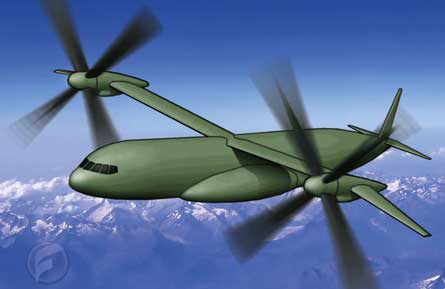US Army-led Joint Heavy Lift (JHL) concept studies are to focus on tiltrotors, in a move to secure support from other services for a large cargo rotorcraft able to transport medium-weight armoured vehicles across the battlefield.
Bell Boeing plans to further refine its Quad Tilt Rotor (QTR) design, Karem Aircraft is expected to advance its Optimum Speed Tilt Rotor (OSTR) and Sikorsky plans to dust off its previous work on a variable-diameter tiltrotor (VDTR).
The latter two are twin-tiltrotor designs: the OSTR (pictured below) has variable-speed rotors to increase efficiency, while the VDTR's blades telescope to increase rotor diameter and lift capability in helicopter mode. The QTR has tandem wings and four smaller rotors.
 |
|---|
© Giuseppe Picarella/Flight International |
The army's Aviation Applied Technology Directorate has selected tiltrotors for further study after industry completed 18-month concept design work on five different JHL configurations, including tandem-rotor and coaxial-rotor helicopters (Flight International, 9-15 October). Conventional rotorcraft could not meet the service's payload/range and speed requirements, say industry sources.
A new US Defense Science Board (DSB) report says a hybrid fixed/rotary-wing aircraft like a tiltrotor is the best option to meet the army's requirements, but warns a 30t-payload vertical-lift aircraft will be costly, risky and take a long time to field.
Col Tim Crosby, army deputy programme executive officer for aviation, says the JHL concept was rejected by a tri-service panel of flag officers, but earlier this year army vice-chief of staff Gen Richard Cody was persuaded to continue with the project on the grounds that the army has a requirement to lift its Future Combat System force.
The original JHL specification was for a 20t-payload, 460km (250nm)-radius vertical take-off and landing aircraft with a Lockheed Martin C-130-class cargo box. But increased FCS vehicle weights have pushed the required payload closer to 30t and the cargo box to Airbus Military A400M size.
The DSB says a 20t-payload, 460km-radius hybrid aircraft is more achievable in the near term and recommends the army modifies the "aerial manoeuvre" operating model driving its requirement to airlift the heavier FCS vehicles across the battlefield.
Industry believes the tiltrotor has been selected because its higher speed and greater payload/range capability will allow the aircraft to perform other missions more efficiently, increasing the chances that other services will help fund development.
The US Air Force is looking at a fixed-wing, C-130 replacement for similar missions under its Advanced Joint Air Combat System initiative, which industry believes will compete for funding with JHL.
Source: Flight International
















